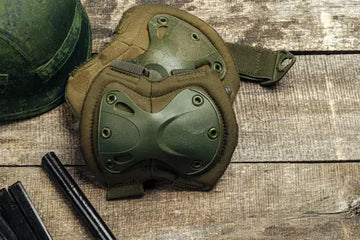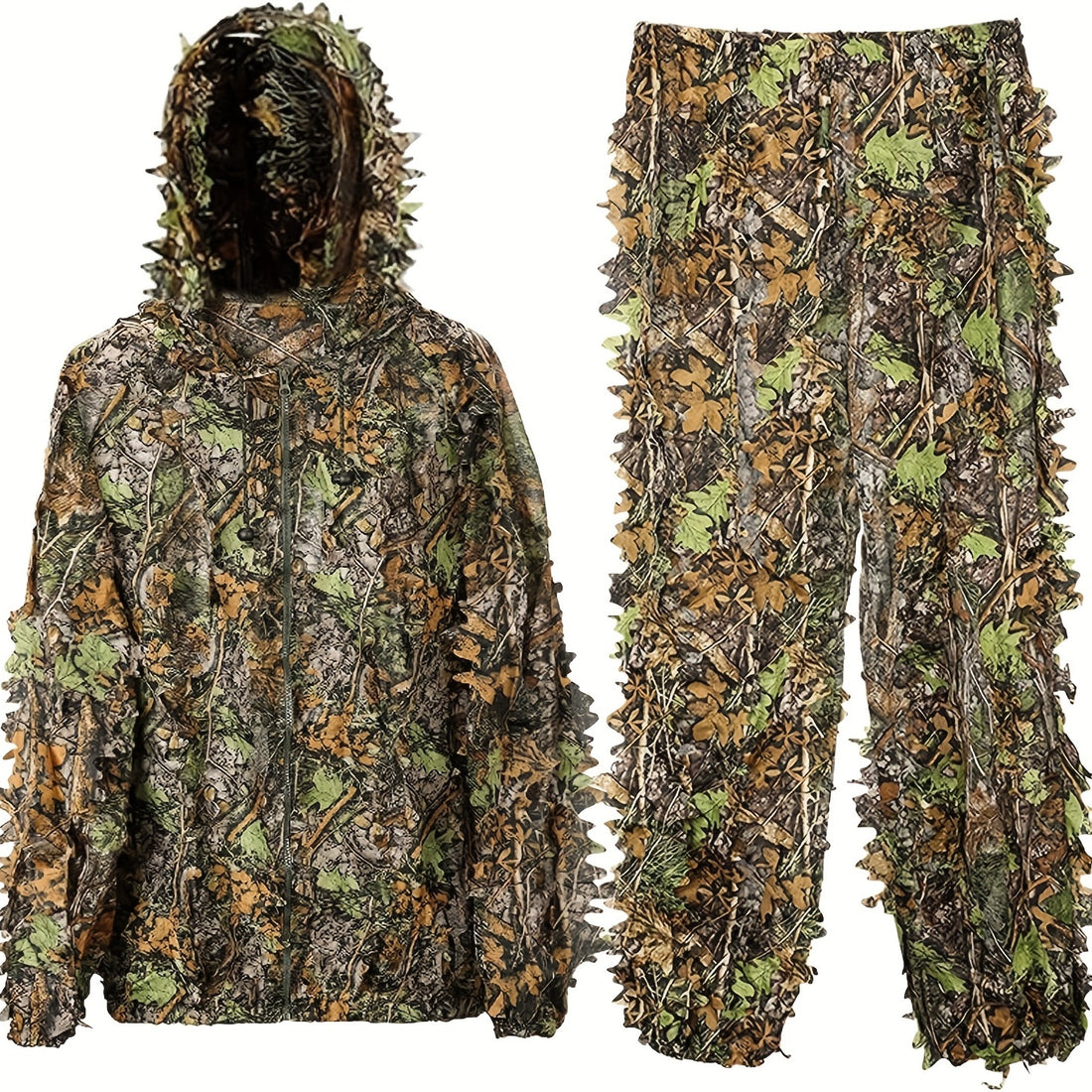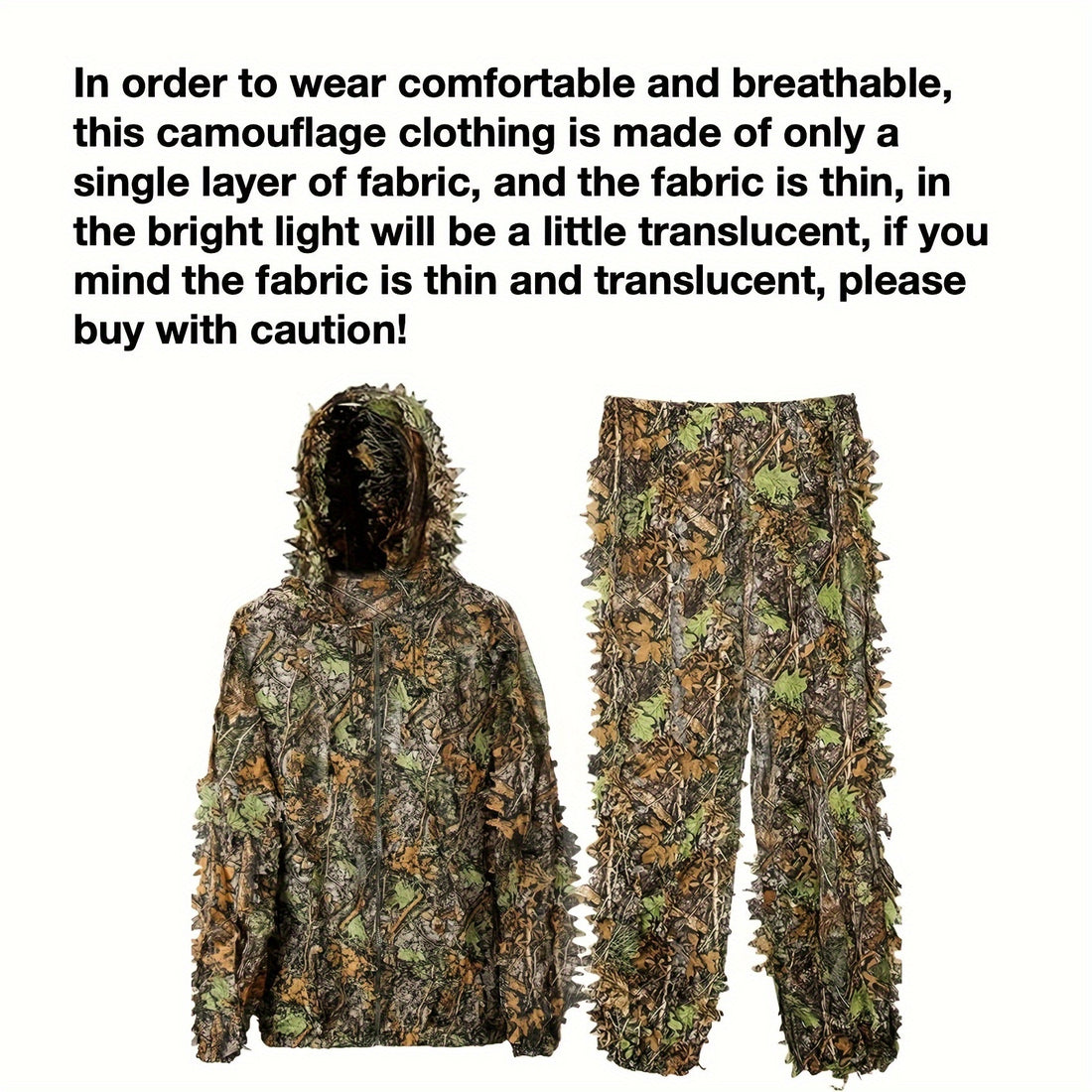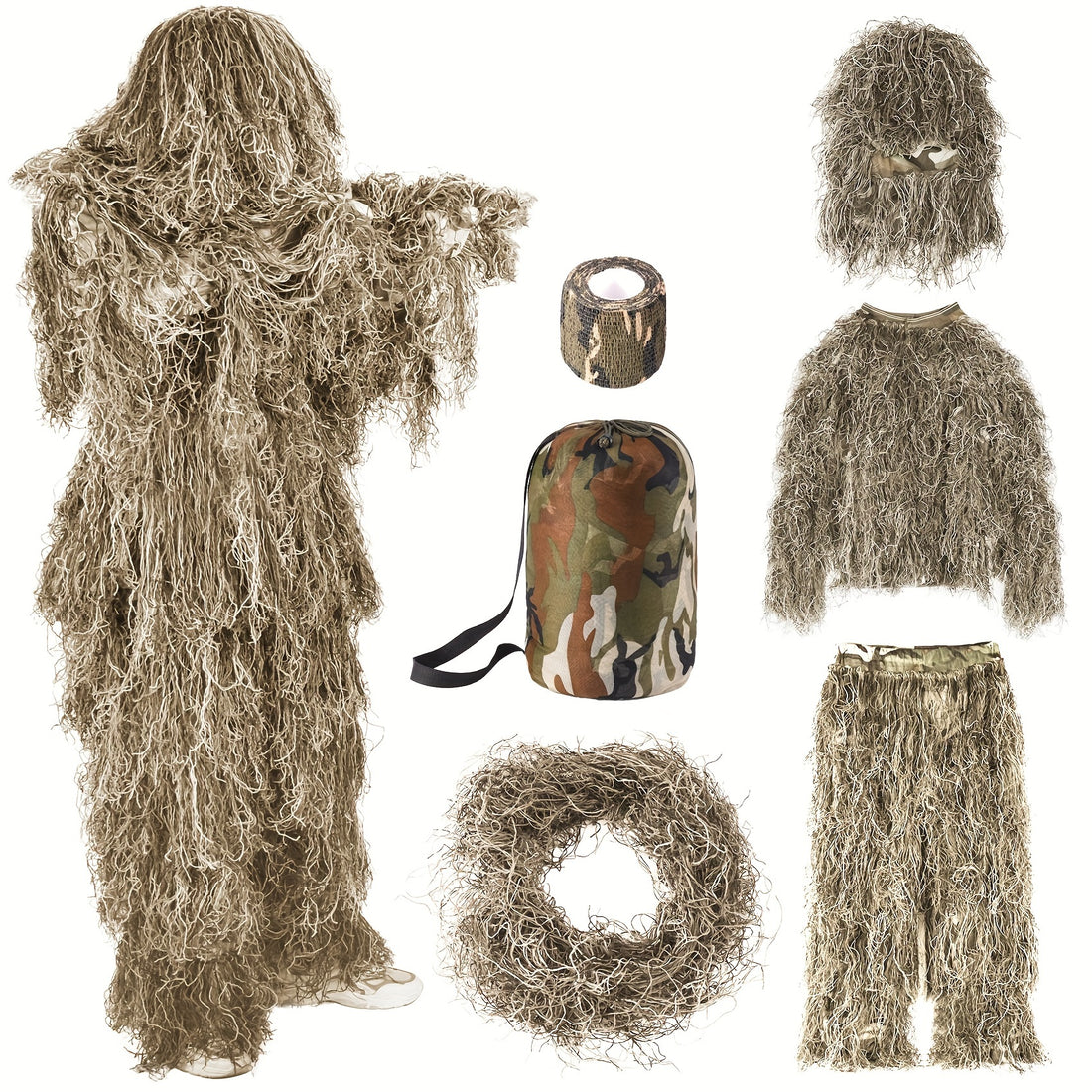Ghillie suits are a fascinating tool for anyone serious about camouflage, whether for hunting, military use, or outdoor sports like airsoft.
In this article, we’ll dive deep into 17 of the most common questions about ghillie suits, providing you with clear and detailed answers.
1. What is a ghillie suit, and what is it used for?
A ghillie suit is a type of camouflage clothing designed to blend into the natural environment.
It's made from netting or cloth and is adorned with strips of fabric, twine, or other materials that resemble foliage.
Originally developed by Scottish gamekeepers, ghillie suits are now widely used by military snipers, hunters, and outdoor sports enthusiasts.
The primary purpose is to make the wearer nearly invisible by breaking up their outline and blending them into their surroundings.
2. Why is it called a ghillie suit?
The term "ghillie suit" originates from Scottish Gaelic. The word "ghillie" (sometimes spelled "gille") originally referred to a type of outdoor servant or gamekeeper in Scotland, whose duties included managing hunting grounds and helping with game stalking.
These ghillies often wore rough, makeshift camouflage clothing made from rags and foliage to blend into the natural environment while hunting or protecting the land.
Over time, the name "ghillie suit" was adopted to describe the specialized camouflage suits used by hunters, military snipers, and outdoor enthusiasts.
They are designed to mimic the appearance of natural surroundings, much like the original attire worn by Scottish ghillies.
The suit’s ability to help the wearer remain hidden in natural settings is what led to its enduring name.
3. How effective is a ghillie suit in providing camouflage?
Ghillie suits are incredibly effective in providing camouflage when used correctly.
The irregular patterns and materials mimic the textures of natural environments, making it difficult for others to detect the wearer.
The effectiveness depends on how well the suit matches the surroundings.
In dense forests, for example, a ghillie suit covered in green and brown materials can make the wearer almost indistinguishable from the foliage.
The limitations? It’s less useful in urban settings where foliage is scarce.
4. What materials are ghillie suits typically made from?
Ghillie suits are typically made from a combination of durable, breathable fabrics such as burlap, jute, or synthetic materials like nylon.
The base of the suit is often a lightweight mesh or cloth that allows air to circulate.
The outer layer consists of strips of fabric, twine, or artificial foliage that are attached to the base, creating the suit's signature shaggy appearance.
Some modern ghillie suits also incorporate flame-retardant materials for added safety.
Burlap’s rugged charm suits DIYers, while synthetics shine for their weight and durability. Pick what fits your budget and needs!
5. How do you choose the best ghillie suit for different environments?
Choosing the right ghillie suit depends on the environment where you plan to use it.
For wooded areas, a suit with green, brown, and black colors works best.
In desert environments, tan and beige tones are more effective.
Snow ghillie suits are typically white with some light gray to mimic shadows in snowy landscapes.
It’s also important to consider the type of foliage in the area. If the environment has a thick brush, adding more texture to your suit can help improve concealment.

6. Can you buy a pre-made ghillie suit, or is it better to make your own?
You’ve got options! You can buy pre-made ghillie suits (expect to pay $50–$150, depending on quality), which are convenient and ready to use. These suits are designed for specific environments and are generally made from high-quality materials.
However, making your own ghillie suit allows for more customization, ensuring that the colors and materials perfectly match the environment you’ll be operating in.
DIY suits can also be tailored to fit your body more comfortably, but they require more time and effort to create.
Check out this tutorial for inspiration.
7. How to make a ghillie suit?
Making a ghillie suit involves a few key steps. Here’s how to build a ghillie suit in 5–10 hours:
- Start with base clothing, like a camo jacket and pants.
-
Attach the netting to these clothes, then cut strips of burlap or jute and dye them in colors that match your environment.
- Tie or sew these strips onto the netting, covering the entire outfit to create a shaggy, textured appearance.
- For extra realism, add natural elements like leaves or twigs. Test the suit in your intended environment and make adjustments as needed.
This DIY approach allows for full customization and ensures your suit blends perfectly with your surroundings.
8. How do you properly fit a ghillie suit to ensure maximum concealment?
To ensure maximum concealment, your ghillie suit should fit loosely but not be overly baggy.
A loose fit allows the suit to move naturally with the wind and mimic the surrounding foliage.
It’s important to make sure that the suit covers your entire body, including your head, hands, and feet.
Many ghillie suits come with adjustable straps or ties, allowing you to secure the suit for a better fit.
Avoid anything that might restrict your movement, as this could compromise your ability to blend in.
9. What are the key differences between a ghillie suit and regular camouflage clothing?
The key difference between a ghillie suit and regular camouflage clothing is the level of concealment they provide.
Regular camouflage clothing typically uses 2D patterns that mimic specific environments, like woodland or desert.
These patterns are effective in breaking up the human silhouette but are not as detailed as ghillie suits.
Ghillie suits, on the other hand, use three-dimensional materials that add texture and depth, making the wearer appear part of the natural environment rather than just blending in with it.
Here’s a quick comparison:
-
Ghillie Suit: 3D, heavier, ultimate concealment.
- Camo Clothing: 2D, lighter, easier to wear.

10. How do you maintain and clean a ghillie suit after use?
Keep your suit in top shape with these steps:
After use, shake off any dirt, leaves, or debris that may have become attached.
If the suit is dirty, spot-clean it with a damp cloth rather than submerging it in water, as soaking can damage the materials.
Air drying is recommended to prevent mold and mildew.
Store the suit in a dry, cool place, and avoid compressing it to maintain the integrity of the materials.
Regularly check for wear and tear, and repair any loose or damaged pieces to keep the suit in top condition.
11. Is it legal to wear a ghillie suit?
Yes, wearing a ghillie suit is generally legal, but it depends on where you are and how you use it.
In many places, there are no laws against wearing one for outdoor activities like hunting, paintball, or airsoft. However, it's important to check local laws before wearing it in public areas.
It’s important to use common sense and be aware of your surroundings. Avoid wearing ghillie suits in sensitive areas like airports, government buildings, or schools, as this could result in legal consequences or misunderstandings with law enforcement.
If you're using it for professional or military purposes, make sure you have the necessary permissions.
12. What are the advantages and disadvantages of using a ghillie suit in hunting?
Ghillie suits shine in hunting by providing superior camouflage, allowing hunters to get closer to their prey without being detected.
The suit’s ability to break up the human outline and blend with the natural environment increases the chances of a successful hunt.
However, Ghillie suits can be bulky and hot, making them uncomfortable to wear for long periods.
They can also snag on branches or brush, which could make movement difficult and noisy.
13. How do ghillie suits perform in different weather conditions, such as rain or snow?
Ghillie suits perform differently depending on the weather.
In rainy conditions, traditional burlap or jute suits can become heavy and waterlogged, reducing mobility and comfort.
However, modern ghillie suits made from synthetic materials are more water-resistant and lighter, making them better suited for wet conditions.
In snow, a specialized snow ghillie suit is necessary to blend into the white surroundings.
These suits are typically lighter and made with materials that won’t absorb moisture.
Always choose a suit that matches the weather conditions to maintain effectiveness.

14. Are ghillie suits comfortable to wear for extended periods?
Ghillie suits are not known for their comfort, especially when worn for extended periods.
The materials used can be heavy and cause the wearer to overheat, particularly in warm climates.
Additionally, the suit’s bulkiness can make movement more challenging.
However, the discomfort is often outweighed by the advantages of superior camouflage.
To improve comfort, look for suits made from lightweight, breathable materials, and consider wearing moisture-wicking clothing underneath to help manage body temperature.
15. What are the safety considerations when using a ghillie suit, especially in the wild?
Safety is a crucial consideration when using a ghillie suit in the wild.
Because these suits are designed to make you blend into the environment, there’s a risk of being mistaken for wildlife by other hunters.
Always be aware of your surroundings and consider wearing some form of identification, like a brightly colored band or vest, when not actively hiding.
Additionally, be cautious in areas with dense vegetation or near bodies of water, as the suit can easily become entangled or waterlogged, posing a risk of tripping or drowning.
16. How do military and law enforcement personnel use ghillie suits in their operations?
Military and law enforcement personnel use ghillie suits primarily for reconnaissance and sniper operations.
The suits allow them to remain hidden while observing or targeting enemies.
In military settings, ghillie suits are often customized with local foliage to match the specific environment.
Law enforcement, particularly SWAT teams, might use ghillie suits during stakeouts or operations requiring stealth.
The use of these suits is highly strategic, providing the advantage of surprise and minimizing the risk of detection during critical missions.
17. What are the best accessories to complement a ghillie suit for complete concealment?
To achieve complete concealment, consider adding accessories that complement your ghillie suit.
Camouflage face paint is essential to cover any exposed skin.
Camouflage gloves and boots help ensure that your entire body blends in with the environment.
You can also use a rifle wrap to camouflage your weapon, preventing it from standing out against the natural background.
Additionally, consider adding natural elements like twigs, leaves, or grass to your suit to enhance its effectiveness further.
These small details can make a difference in how well you blend into your surroundings.
Where to Buy Ghillie Suits
Looking for a high-quality ghillie suit? Check out these trusted brands:
-
Arcturus: Lightweight suits, $70–$120, great for hunting and airsoft.
-
Red Rock Outdoor Gear: Budget-friendly, $50–$100, reliable camouflage.
-
North Mountain Gear: Leafy designs, $80–$150, ideal for woodlands.
-
Bushrag: Customizable options, $150–$300, pro-level quality.
- GhillieSuits.com: Versatile kits and suits, $60–$200, sniper-ready.
Wrapping Up
These 17 questions cover everything you need to know about ghillie suits—from crafting your own to staying safe in the wild.
Whether you're a hunter, a military professional, or an outdoor enthusiast, understanding these aspects will help you make the most of your ghillie suit and stay hidden in plain sight.


























